How well do Assassin's Creed II missions use the open world?
Creating and filling open worlds is a tricky task. On the one hand, they should be large, extensive, give a feeling of a huge sandbox in which to play, and stimulate interest in research. On the other hand, they should not cause a feeling of emptiness and lack of action. They must have content. Almost all open world games (I don’t consider RPGs) try to smooth this problem by distributing collection items around the world. Such content, if the player decides to collect it all, allows you to explore each section of the map. But, honestly, I consider the majority of collection items of low value trash. Much more important is how the world is used in missions or in other real content. I think the Assassin's Creed II game is a good example of using the open world in missions.
I think the remarkable feature of the Assassin's Creed II open world (which in this respect preserves the principles of the open world of the first game) is that the world opens step by step to the very last stages of the game. This approach is very different from the many modern open-world games (including later versions of Assassin's Creed), in which the player is first limited to a small space at the introduction stage, and then the whole world opens to him. In this approach, of course, there is nothing bad, but there are certain advantages in the way Assassin's Creed II handles the space of the world.
The game has two large cities, divided into several districts, and three smaller ones, each of which is essentially one district, covering the entire game area. In each part of the game opens a new area in which the main action of the game. Additional missions are used to fill gaps in the occupied space. As a result, if a player passes only the main story, then he will visit a significant part of the open world. If he does additional missions, he explores almost the entire map. In this case, he will deal with important content, and not just collect collectibles.
')
Below is a breakdown of all areas discovered during parts of the main story. Generally speaking, the main missions are also concentrated in this area, with the exception of small towns, which usually open first to one “teaser” mission, and then the main action is transferred to them.
Part 1 - Florence - San Giovanni area
Part 2 - Florence - San Marco District
Part 3 - Monteriggioni and San Gimignano (1 mission “teaser”)
Part 4 - Florence - Santa Maria Novella District
Part 5 - San Gimignano (main action)
Part 6 - Apennines and Forli (1 mission- "teaser")
Part 7 - Venice - San Polo District
Part 8 - Venice - San Marco District
Part 9 - Venice - Dorsoduro District
Part 10 - Venice - Castello District
Part 11 - Venice - Cannaregio
Part 12 - Forlie (main action)
Part 13 - Florence - Oltrarno
Part 14 - Rome - Vatican
In order to better visualize the use of the open world in basic and additional missions, I created “heat maps” of mission design (you can click on the pictures to enlarge). The legend of all the cards is very simple:
Green is the area that the player is almost likely to visit and explore, because the design of the missions is related to it (this may be the sandbox area for the penetration mission, the search area, the specific path that the character should follow, etc.).
Yellow - Uncertain areas that a player may visit during a mission. These are mainly possible routes from point A to point B (i.e., different paths are included), or escape routes after a murder, etc. In general, the brighter the yellow, the more likely it is that players explore the appropriate part of the map during missions.
Note: on the maps there is NO anything related to collection items or arbitrary exploration of the open world, only missions.
Venice
I will start with Venice. If you read my previous posts about Assassin's Creed II, you probably know that I had a lot of problems with that part of the game that takes place in Venice. Among other things, the development of the narrative is interrupted here, part 9 (“Carnival”) looks meaningless, and part 10 (Arsenal) is boring and redundant. Be that as it may, this does not apply to the main theme: the use of space in missions. In this regard, Venice seems to me to be an excellent example to begin the analysis. It should be noted that in part 8 we use a flying machine, thanks to which half of the city becomes accessible, but the narration is concentrated in the central area of San Marco.
Part 7

Part 8

Part 9
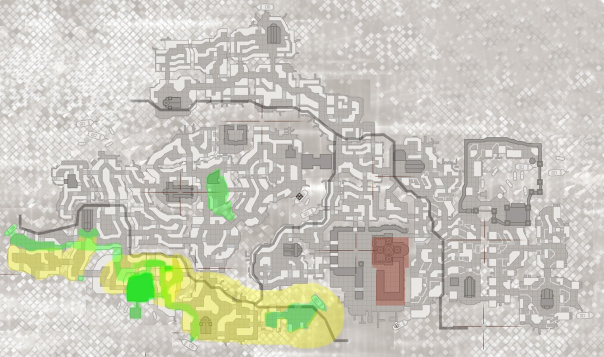
Part 10

Part 11
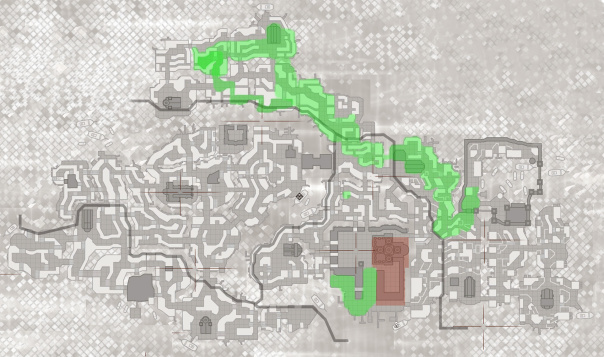
All Venetian Parts
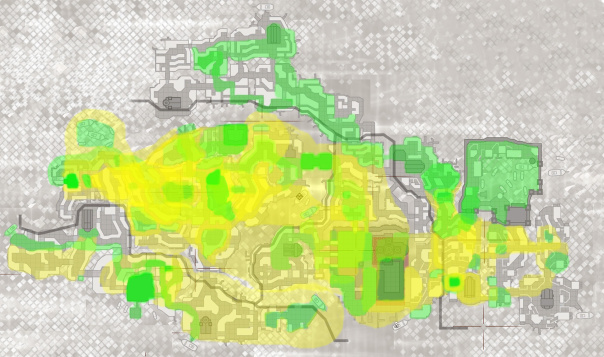
Additional missions
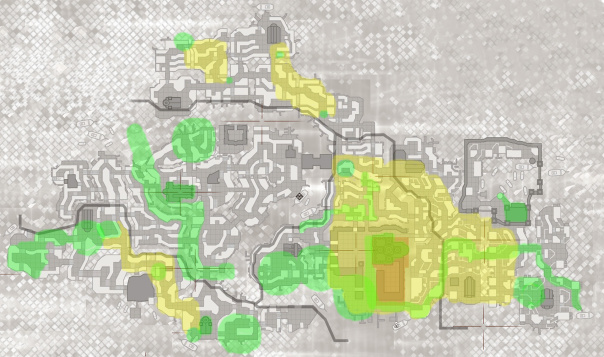
All major and additional missions
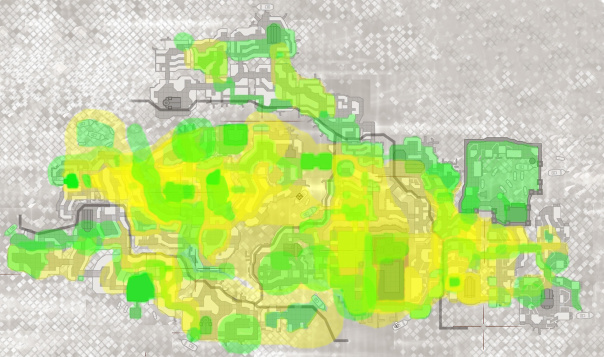
Florence
Florence is interesting for several reasons.
- Only the first part makes full use of the area in which it occurs (by the way, a large green spot is the Auditor’s house).
- In parts 2 and 4 only half of the areas they unblocked are used, the rest of the action revolves around the area of the character’s home.
- On the other hand, in part 13, all spaces left in these parts are filled.
- The player re-visits Florence during the main story in Parts 5 and 6, too, just to meet and talk with Lorenzo Medici and Leonardo da Vinci.
- There are no additional missions in the Oltrarno area, because they will be unlocked later in the DLC.
- You may notice that the outskirts of the city are not usually used in missions. I think this is done in order to create a feeling that the space is larger than it actually is.
Despite all these interesting moments, the result remains about the same: after passing the story, the player has already explored most of the space available in the game.
Part 1
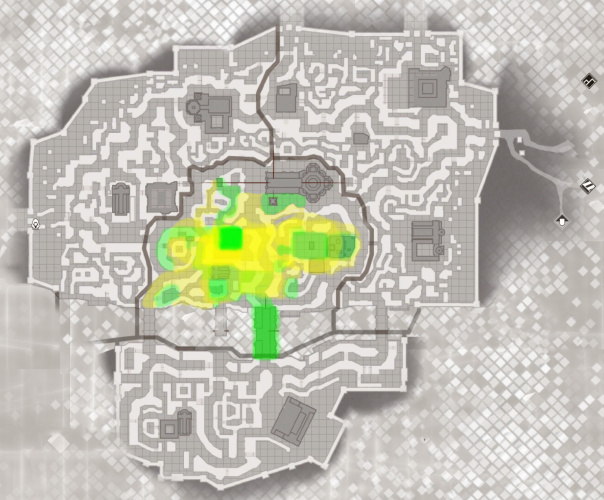
Part 2
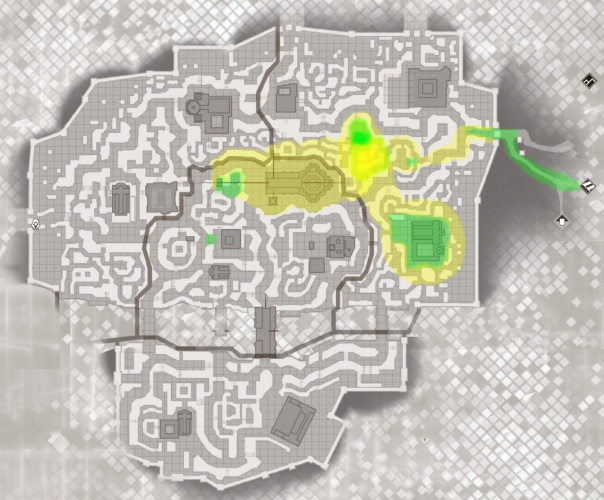
Part 4

Parts 5 and 6

Part 13
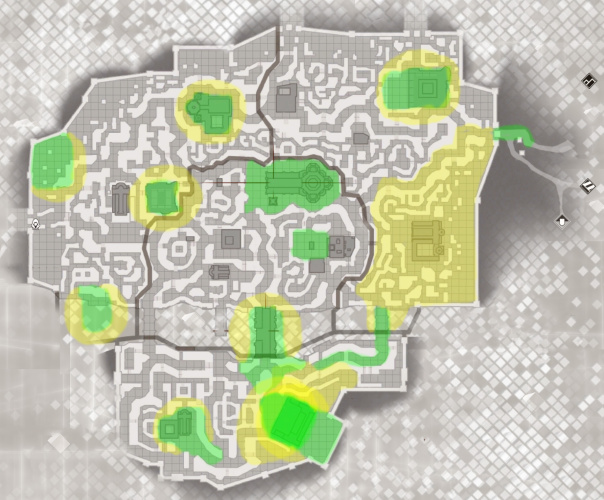
All Florentine pieces

Additional missions
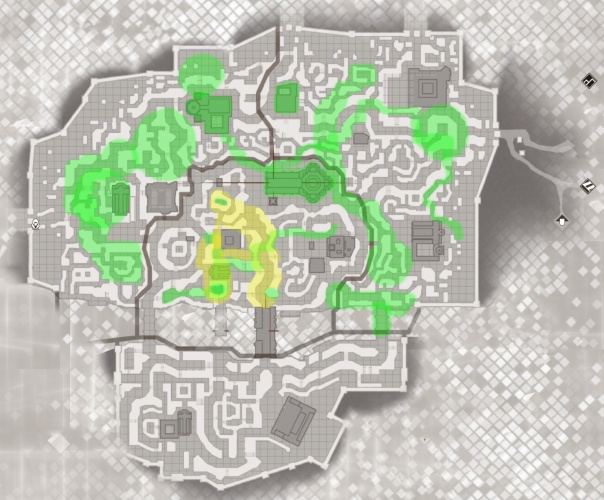
All major and additional missions
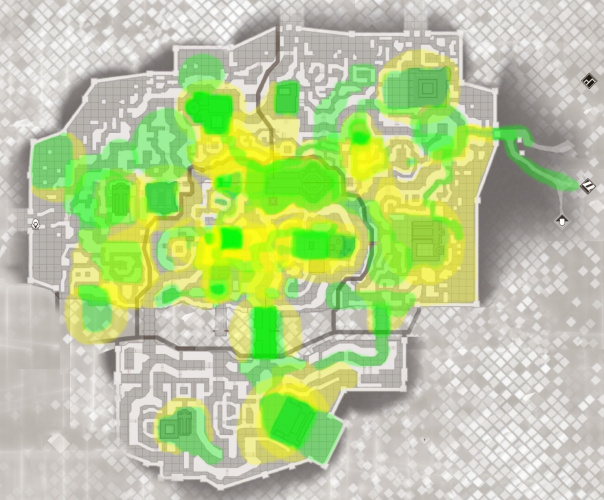
San gimignano
In the main story, San Gimignano is used in one mission from part 3 and in almost all part 5. It seemed to me interesting that the game managed to use almost the entire vast space, but in the east there is a whole region with a small town that was not used at all in missions. This is strange, because some primary and secondary missions occur in the same places, and if the creators, for example, moved part of the murder contracts to this area, this would solve the problem.
Major Missions (Parts 3 and 5)

Additional missions

All major and additional missions

Forli
Like San Gimignano, the player visits Forli once in Part 6, but this city is fully used by the main story only in Part 12. This part belongs to the DLC, so if you do not have a DLC and you do not play the PC version, which this city is included immediately, then Forli you almost never tasted.
Major Missions (Parts 6 and 12)
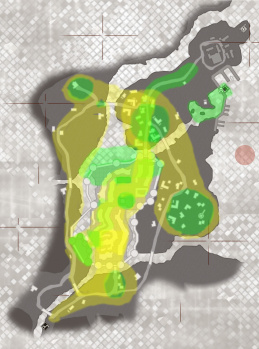
Additional missions

All major and additional missions
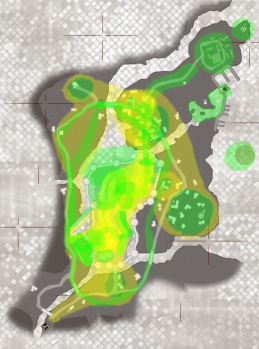
Monteriggioni
Although the main action in Monteriggioni falls on part 3, we often visit this city during the main story. Basically to talk to someone at the villa. In addition, there is the background of the restoration cycle of the entire city, which is incredibly close acquaint the player with this town. Therefore, although only the central street and the Auditor's villa can be involved in the main missions, and there is only one additional mission in the whole game, this place is still felt for the player as the house in which he studied every nook and cranny. I especially like the way the city is changing significantly, gradually improving. It is really very exciting.
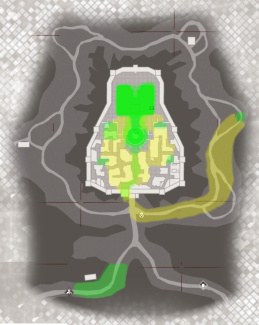
So, I conducted an analysis of how the open world space is used in Assassin's Creed II. Although the game still has collectible items, for example, 100 feathers and a few hundred chests, the player does not have to look for them all in order to appreciate most of the world that the developers have created. The system is configured in such a way that almost everything is shown in the main and additional missions.
Of course, this approach is not always possible to use in the game, and it is not the only correct one. But I find such a structure for using the open world quite good, and not as frightening as traditional open worlds. Sometimes they open sharply too large spaces, the thought of exploring which is overwhelming. But not in the case of Assassin's Creed II.
Thank you for reading the article, I hope it seemed interesting to you. Feel free to leave comments and follow us on Twitter: @ farlander1991 .
I think the remarkable feature of the Assassin's Creed II open world (which in this respect preserves the principles of the open world of the first game) is that the world opens step by step to the very last stages of the game. This approach is very different from the many modern open-world games (including later versions of Assassin's Creed), in which the player is first limited to a small space at the introduction stage, and then the whole world opens to him. In this approach, of course, there is nothing bad, but there are certain advantages in the way Assassin's Creed II handles the space of the world.
The game has two large cities, divided into several districts, and three smaller ones, each of which is essentially one district, covering the entire game area. In each part of the game opens a new area in which the main action of the game. Additional missions are used to fill gaps in the occupied space. As a result, if a player passes only the main story, then he will visit a significant part of the open world. If he does additional missions, he explores almost the entire map. In this case, he will deal with important content, and not just collect collectibles.
')
Below is a breakdown of all areas discovered during parts of the main story. Generally speaking, the main missions are also concentrated in this area, with the exception of small towns, which usually open first to one “teaser” mission, and then the main action is transferred to them.
Part 1 - Florence - San Giovanni area
Part 2 - Florence - San Marco District
Part 3 - Monteriggioni and San Gimignano (1 mission “teaser”)
Part 4 - Florence - Santa Maria Novella District
Part 5 - San Gimignano (main action)
Part 6 - Apennines and Forli (1 mission- "teaser")
Part 7 - Venice - San Polo District
Part 8 - Venice - San Marco District
Part 9 - Venice - Dorsoduro District
Part 10 - Venice - Castello District
Part 11 - Venice - Cannaregio
Part 12 - Forlie (main action)
Part 13 - Florence - Oltrarno
Part 14 - Rome - Vatican
In order to better visualize the use of the open world in basic and additional missions, I created “heat maps” of mission design (you can click on the pictures to enlarge). The legend of all the cards is very simple:
Green is the area that the player is almost likely to visit and explore, because the design of the missions is related to it (this may be the sandbox area for the penetration mission, the search area, the specific path that the character should follow, etc.).
Yellow - Uncertain areas that a player may visit during a mission. These are mainly possible routes from point A to point B (i.e., different paths are included), or escape routes after a murder, etc. In general, the brighter the yellow, the more likely it is that players explore the appropriate part of the map during missions.
Note: on the maps there is NO anything related to collection items or arbitrary exploration of the open world, only missions.
Venice
I will start with Venice. If you read my previous posts about Assassin's Creed II, you probably know that I had a lot of problems with that part of the game that takes place in Venice. Among other things, the development of the narrative is interrupted here, part 9 (“Carnival”) looks meaningless, and part 10 (Arsenal) is boring and redundant. Be that as it may, this does not apply to the main theme: the use of space in missions. In this regard, Venice seems to me to be an excellent example to begin the analysis. It should be noted that in part 8 we use a flying machine, thanks to which half of the city becomes accessible, but the narration is concentrated in the central area of San Marco.
Part 7

Part 8

Part 9

Part 10

Part 11

All Venetian Parts

Additional missions

All major and additional missions

Florence
Florence is interesting for several reasons.
- Only the first part makes full use of the area in which it occurs (by the way, a large green spot is the Auditor’s house).
- In parts 2 and 4 only half of the areas they unblocked are used, the rest of the action revolves around the area of the character’s home.
- On the other hand, in part 13, all spaces left in these parts are filled.
- The player re-visits Florence during the main story in Parts 5 and 6, too, just to meet and talk with Lorenzo Medici and Leonardo da Vinci.
- There are no additional missions in the Oltrarno area, because they will be unlocked later in the DLC.
- You may notice that the outskirts of the city are not usually used in missions. I think this is done in order to create a feeling that the space is larger than it actually is.
Despite all these interesting moments, the result remains about the same: after passing the story, the player has already explored most of the space available in the game.
Part 1

Part 2

Part 4

Parts 5 and 6

Part 13

All Florentine pieces

Additional missions

All major and additional missions

San gimignano
In the main story, San Gimignano is used in one mission from part 3 and in almost all part 5. It seemed to me interesting that the game managed to use almost the entire vast space, but in the east there is a whole region with a small town that was not used at all in missions. This is strange, because some primary and secondary missions occur in the same places, and if the creators, for example, moved part of the murder contracts to this area, this would solve the problem.
Major Missions (Parts 3 and 5)

Additional missions

All major and additional missions

Forli
Like San Gimignano, the player visits Forli once in Part 6, but this city is fully used by the main story only in Part 12. This part belongs to the DLC, so if you do not have a DLC and you do not play the PC version, which this city is included immediately, then Forli you almost never tasted.
Major Missions (Parts 6 and 12)

Additional missions

All major and additional missions

Monteriggioni
Although the main action in Monteriggioni falls on part 3, we often visit this city during the main story. Basically to talk to someone at the villa. In addition, there is the background of the restoration cycle of the entire city, which is incredibly close acquaint the player with this town. Therefore, although only the central street and the Auditor's villa can be involved in the main missions, and there is only one additional mission in the whole game, this place is still felt for the player as the house in which he studied every nook and cranny. I especially like the way the city is changing significantly, gradually improving. It is really very exciting.

So, I conducted an analysis of how the open world space is used in Assassin's Creed II. Although the game still has collectible items, for example, 100 feathers and a few hundred chests, the player does not have to look for them all in order to appreciate most of the world that the developers have created. The system is configured in such a way that almost everything is shown in the main and additional missions.
Of course, this approach is not always possible to use in the game, and it is not the only correct one. But I find such a structure for using the open world quite good, and not as frightening as traditional open worlds. Sometimes they open sharply too large spaces, the thought of exploring which is overwhelming. But not in the case of Assassin's Creed II.
Thank you for reading the article, I hope it seemed interesting to you. Feel free to leave comments and follow us on Twitter: @ farlander1991 .
Source: https://habr.com/ru/post/319544/
All Articles